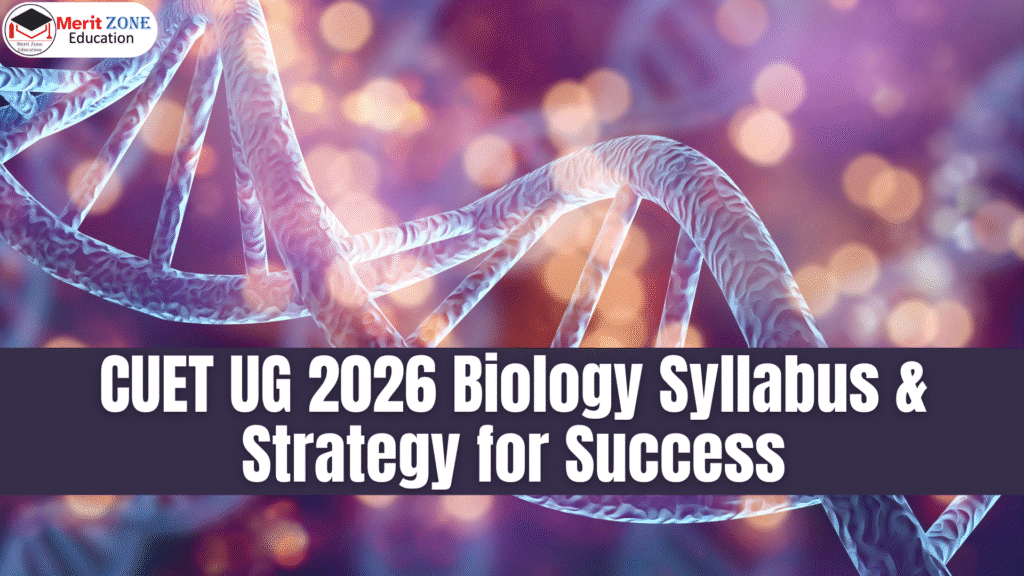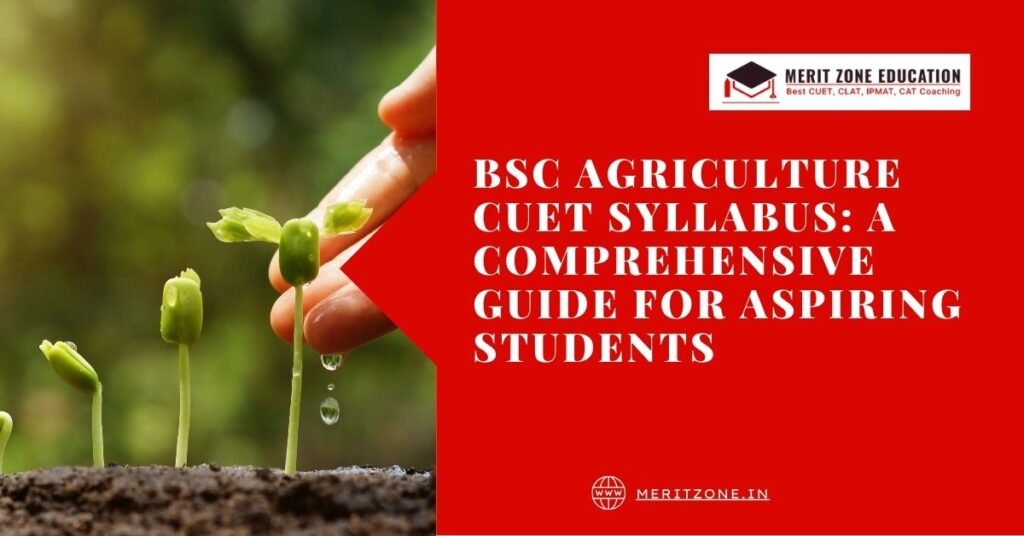CUET UG Biology 2026 Syllabus & Preparation Strategy

If Biology is your passion, and you’re dreaming of pursuing courses like B.Sc. If you are in Biology, Biotechnology, Microbiology, Physiotherapy, Nursing, Agriculture, or any Life Science program, then CUET UG 2026 Biology is your gateway to top universities in India. With increasing competition and thousands of seats in the Central Universities, you want to score well to secure a seat in Delhi Universities, BHU, Allahabad University, and many more prestigious institutes.
But the truth is, biology may seem vast, and without knowing the syllabus and the right strategy plan, you waste your time on knowing the syllabus and chapters that carry less weight. So, in this article, MeritZone breaks down the syllabus of Biology and the best strategy plan that helps you to score well in the exam.
CUET UG Biology 2026 Syllabus
The Syllabus of Biology is divided into 5 units, and here’s the exact breakdown of chapters in Biology.
Unit-I Reproduction
Chapter-1: Sexual Reproduction in Flowering Plants:- Flower structure; development of male and female gametophytes; pollination – types, agencies and examples; out breeding devices; pollen-pistil interaction; double fertilization; post fertilization events – development of endosperm and embryo, development of seed and formation of fruit; special modes- apomixis, parthenocarpy, polyembryony; Significance of seed dispersal and fruit formation.
Chapter-2: Human Reproduction:- Male and female reproductive systems; microscopic anatomy of testis and ovary; gametogenesis -spermatogenesis and oogenesis; menstrual cycle; fertilisation, embryo development upto blastocyst formation, implantation; pregnancy and placenta formation (elementary idea); parturition (elementary idea); lactation (elementary idea).
Chapter-3: Reproductive Health– Need for reproductive health and prevention of Sexually Transmitted Diseases (STDs); birth control – need and methods, contraception and medical termination of pregnancy (MTP); amniocentesis; infertility and assisted reproductive technologies – IVF, ZIFT, GIFT (elementary idea for general awareness).
Unit-II Genetics and Evolution
Chapter-4: Principles of Inheritance and Variation:- Heredity and variation: Mendelian inheritance; deviations from Mendelism – incomplete dominance, co-dominance, multiple alleles and inheritance of blood groups, pleiotropy; elementary idea of polygenic inheritance; chromosome theory of inheritance; chromosomes and genes; Sex determination – in humans, birds and honey bee; linkage and crossing over; sex linked inheritance – haemophilia, colour blindness; Mendelian disorders in humans – thalassemia; chromosomal disorders in humans; Down’s syndrome, Turner’s and Klinefelter’s syndromes.
Chapter-5: Molecular Basis of Inheritance:- Search for genetic material and DNA as genetic material; Structure of DNA and RNA; DNA packaging; DNA replication; Central Dogma; transcription, genetic code, translation; gene expression and regulation – lac operon; Genome, Human and rice genome projects; DNA fingerprinting.
Chapter-6: Evolution Origin of life:- biological evolution and evidences for biological evolution (paleontology, comparative anatomy, embryology and molecular evidences); Darwin’s contribution, modern synthetic theory of evolution; mechanism of evolution – variation (mutation and recombination) and natural selection with examples, types of natural selection; Gene flow and genetic drift; Hardy- Weinberg’s principle; adaptive radiation; human evolution.
Unit-III: Biology and Human Welfare
Chapter-7: Human Health and Disease Pathogens:-parasites causing human diseases (malaria, dengue, chikungunya, filariasis, ascariasis, typhoid, pneumonia, common cold, amoebiasis, ring worm) and their control; Basic concepts of immunology – vaccines; cancer, HIV and AIDS; Adolescence – drug and alcohol abuse.
Chapter-8: Microbes in Human Welfare:- Microbes in food processing, industrial production, sewage treatment, energy generation and microbes as bio-control agents and bio-fertilisers. Antibiotics: production and judicious use.
Unit-IV Biotechnology and its Applications
Chapter-9: Biotechnology:– Principles and Processes Genetic Engineering (Recombinant DNA Technology).
Chapter-10: Biotechnology and its Applications Application of biotechnology in health and agriculture:– Human insulin and vaccine production, stem cell technology, gene therapy; genetically modified organisms – Bt crops; transgenic animals; biosafety issues, biopiracy and patents.
Unit-V Ecology and Environment
Chapter-11: Organisms and Populations Population interactions:- mutualism, competition, predation, parasitism; population attributes – growth, birth rate and death rate, age distribution. (Topics excluded: Organism and its Environment, Major Abiotic Factors, Responses to Abiotic Factors, Adaptations)
Chapter-12: Ecosystems:– Patterns, components, productivity and decomposition, energy flow; pyramids of number, biomass, energy (Topics excluded: Ecological Succession and Nutrient Cycles).
Chapter-13: Biodiversity and Conservation Biodiversity:- Concept, patterns, importance; loss of biodiversity; biodiversity conservation; hotspots, endangered organisms, extinction, Red Data Book, Sacred Groves, biosphere reserves, national parks, wildlife, sanctuaries and Ramsar sites.
CUET 2026 Biology Preparation Strategy (By MeritZone Experts)
Preparing for CUET Biology becomes smooth and stress-free when you follow expert guidance and a well-structured study plan. With the right coaching support, even the most complex chapters start making sense — helping you score the top percentile and secure admission to your dream university. At MeritZone Education, our mission is simple: Make Biology easy, make preparation strategic, make results outstanding.
At MeritZone Education, our mission is simple: Make Biology easy, make preparation strategic, make results outstanding.
NCERT — The Core Foundation
CUET Biology is built on NCERT Class 11 & 12. MeritZone ensures students learn concepts, not just lines, by: Detailed NCERT breakdown & explanation classes, Important diagrams highlighted and practised regularly, Daily recall quizzes to strengthen fundamentals. Because when NCERT is strong, CUET becomes predictable.
Visual Learning for Better Retention
Biology is a visual subject. That’s why we include: Mind maps & flowcharts for every chapter, Mnemonic tricks for tough terms, Live diagram workshops for scoring perfection. This approach boosts memory and reduces revision time.
PYQs & CUET Trend-Based Preparation
MeritZone teaches students to decode the exam using: Topic-wise CUET Previous Year Questions, High-weightage chapter lists, Exam-style sectional drills. Students quickly learn what matters most for marks — and focus smart.
Weekly Mock Tests + Deep Analysis
MeritZone doesn’t just conduct tests — we analyse performance and fix mistakes: Speed & accuracy tracking, Question-solving pattern analysis, Personalised improvement feedback, Risk-based strategy for negative marking. Every mock test pushes you one step ahead in rank.
Conclusion
Biology is not a difficult subject; it simply requires the right strategy. With strong NCERT command, active revision techniques, continuous practice, and expert mentorship, your CUET Biology score can reach its highest potential. At MeritZone Education, we ensure that students build clarity, confidence, and exam-ready skills from day one through structured classes, top-quality study material, and real CUET-pattern test series. Join MeritZone CUET Biology Coaching Today — Online or Offline.


